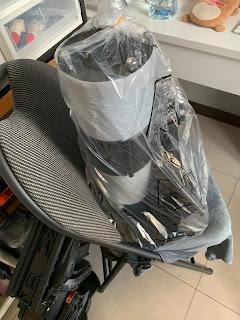The color of the new Orion StarBlast Dobsonian telescope is a remarkable story to behold
Many white OTA telescopes had flooded the market in the past and white became so common that many telescope makers began using alternate black color.
After a number of years of stumbling over and into black telescopes in the darkness of night, black was deemed no longer creative and Orion began looking for new colors of originality for the lineup.
Signature red was of course taken up by Edmunds red Astroscan telescope and Celestron made a popular line of orange Schmidt-cassegrain telescopes.
In 2003, the California-based Orion Telescopes and Binoculars introduced the StarBlast, a 4.5-inch Newtonian reflector grab and go telescope with a Dobsonian mount. The telescope became popular with both kids and adults and even libraries have some for checkout. When Orion Telescope Company formulated the signature StarBlast OTA color, they went a step further than white or black and formulated metal teal pearl color. The tube finishes were embedded with scintillating sparkles of a metal appearance (a borrowed technique of creating finer car finishes). Under certain lighting it looked like tiny pinpoint stars making up the tube finish, a fantastic and very original sight to behold.
The most creative and unusual esteemed and royal colors were sought after and reviewed. Teal was a new web color formulated in 1987.
In the 1990's Teal was a cyan-green fad color for sports and it was adopted by many teams for the color of their uniforms. The color is believed to originate from the common Teal, a member of the duck family whose eyes are surrounded by this color.
Teal green is a darker shade of teal with more green and is a variable color averaging a dark bluish green that is green, darker, and stronger than invisible green or pine tree. Teal green is most closely related to the Crayola crayon color Deep Space Sparkle. Air New Zealand picked Teal green as their signature airline color.
In 2003, the California-based Orion Telescopes and Binoculars introduced the StarBlast, a 4.5-inch Newtonian reflector grab and go telescope with a Dobsonian mount. The telescope became popular with both kids and adults and even libraries have some for checkout. When Orion Telescope Company formulated the signature StarBlast OTA color, they went a step further than white or black and formulated metal teal pearl color. The tube finishes were embedded with scintillating sparkles of a metal appearance (a borrowed technique of creating finer car finishes). Under certain lighting it looked like tiny pinpoint stars making up the tube finish, a fantastic and very original sight to behold.





















